A NEW WORLD POWER (1898–1945)
Expansion and Imperialism
After the War of 1812 the people of the United States had concentrated almost entirely on what was happening within their borders. Their attitude changed rather abruptly in 1898.
Almost all the countries of Latin America had become independent from Spain early in the 1800s. One that hadn't was Cuba. Cubans were weary of Spanish rule by the end of the 1800s. Many people in the United States sympathized with Cuba's desire for independence.
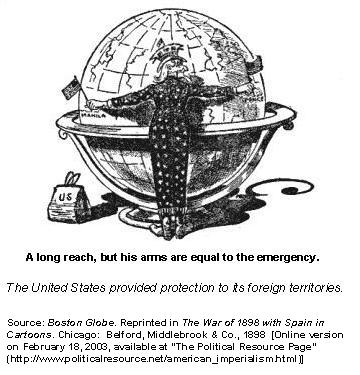 In February of 1898, the U.S. battleship Maine was mysteriously blown up on a visit to Cuba. More than 200 U.S. sailors were killed in the explosion. U.S. newspapers immediately demanded war against Spain, and most people agreed with the newspapers. President William McKinley reluctantly gave in.
In February of 1898, the U.S. battleship Maine was mysteriously blown up on a visit to Cuba. More than 200 U.S. sailors were killed in the explosion. U.S. newspapers immediately demanded war against Spain, and most people agreed with the newspapers. President William McKinley reluctantly gave in.
The Spanish-American War was the shortest and most easily won war in U.S. history. Within just a few weeks U.S. forces destroyed the Spanish ships and defeated the Spanish soldiers in Cuba. At the same time, Admiral George Dewey took the U.S. Pacific fleet into the Philippines on the other side of the world. The Philippine Islands were also controlled by Spain. Dewey destroyed the Spanish fleet there.
In the peace treaty, Spain agreed to withdraw from Cuba. It ceded Puerto Rico and the Pacific island of Guam to the United States. It also gave up the Philippines, which it had ruled for more than 350 years. The United States paid Spain $20 million for the Philippines.
The United States recognized Cuba's independence but demanded, and received, special trade rights along with the right to build naval bases on the island. The United States was especially interested in Cuba's sugar-growing industry. For many years Cuba supplied most of the sugar used in the United States.
The United States governed the Philippines, Puerto Rico, and Guam as its own territories. In the same year, the United States acquired Hawaii. A peaceful revolution took place there, supported by American pineapple growers in the islands. The United States had embraced imperialism. It now ruled lands far beyond its own borders.
Back to Top
World War I
When he retired, President George Washington had warned the new nation of the United States not to get involved in Europe's wars. The country followed his advice as long as possible. But once the United States became a world power, it was difficult to ignore what went on in Europe.
Fighting in Europe died down during the 1800s. Many countries were busy building industries and conquering colonies in Asia and Africa. People even began to hope that wars in Europe were a thing of the past. Yet, during those same years, industry was developing new and terrible weapons. The Civil War showed how murderous some of the new weapons were. European leaders, however, learned no lessons from that war.
By the early 1900s European leaders were forming military alliances that lined up some nations against others. Under these alliances separate nations banded together. They signed treaties that said the nations would support one another in case any of them was attacked.
One European alliance was made between England, France, and Russia (the Allied Powers). Opposing them was the alliance formed by Germany, Austria-Hungary, and Turkey (the Central Powers). Germany wanted to be a major imperialist power, but France and England already ruled most of the overseas colonies of the day.
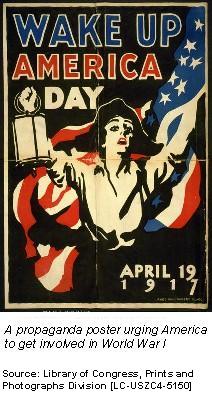 As war threatened, Russia called up its troops. This worried Germany because it was caught between Russia on the east and France on the west. So the Germans invaded Belgium to get into France before the Russians attacked them. Belgium had an alliance with England, so England declared war on Germany when it invaded Belgium. World War I had begun.
As war threatened, Russia called up its troops. This worried Germany because it was caught between Russia on the east and France on the west. So the Germans invaded Belgium to get into France before the Russians attacked them. Belgium had an alliance with England, so England declared war on Germany when it invaded Belgium. World War I had begun.
President Woodrow Wilson tried to keep the United States out of Europe's war. He succeeded for more than three years. Most Americans wanted to stay out of the war, although many sympathized with England and France.
One terrible new weapon of the war was poisonous gas. This was also the first major war that made use of the airplane and the submarine. The Germans had more submarines than anyone else and used them to sink hundreds of enemy ships. It also sank several unarmed U.S. ships that were carrying supplies to England and France. Wilson protested, but the Germans continued to sink U.S. ships. In April of 1917, the United Stated declared war on Germany.
German armies had advanced far into France in the first month of the war. French and English armies had been able to stop them. Both sides dug trenches along 300 miles from the French coast to the border of Switzerland. Despite bitter fighting, these battle lines changed little over four years.
When the United States entered the war, the battle-weary armies on both sides seemed too exhausted ever to win the war. Fresh U.S. troops turned the tide of battle and forced the Germans to retreat. Germany surrendered in November of 1918. Millions of soldiers and civilians had been killed.
President Wilson wanted this "Great War" to be "the war that ends all wars." But that was not to be.
Back to Top
The Roaring Twenties
After World War I, President Wilson succeeded in getting other countries of the world to accept his plan for a League of Nations. This league was an organization aimed at keeping peace among nations. All countries could send representatives to its meeting place in Geneva, Switzerland. But Wilson could not persuade his own nation to join the League of Nations. The majority of Americans decided they wanted no part of the world's problems. They turned their backs on the rest of the world and entered the fun-loving decade of the 1920s.
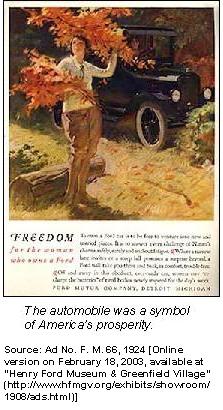 For the first time, U.S. factories were mass-producing automobiles. Almost anyone could afford a car. A new Model T Ford cost only a few hundred dollars. Hollywood became the movie capital of the world and produced cheap entertainment for everyone. The new radios were just as inexpensive. A small one cost about $20 and lasted for years. Radios and phonograph records both helped to make the lively new jazz music popular. Prohibition took effect in 1920, making the sale of alcoholic beverages illegal. Gangsters quickly began to make their own liquor and beer and sold it in "speakeasies." Speakeasies were nightclubs that ignored prohibition laws. Crime rose rapidly during the 1920s.
For the first time, U.S. factories were mass-producing automobiles. Almost anyone could afford a car. A new Model T Ford cost only a few hundred dollars. Hollywood became the movie capital of the world and produced cheap entertainment for everyone. The new radios were just as inexpensive. A small one cost about $20 and lasted for years. Radios and phonograph records both helped to make the lively new jazz music popular. Prohibition took effect in 1920, making the sale of alcoholic beverages illegal. Gangsters quickly began to make their own liquor and beer and sold it in "speakeasies." Speakeasies were nightclubs that ignored prohibition laws. Crime rose rapidly during the 1920s.
Most people during the 1920s had jobs and paychecks. With so much money around, people began playing the stock market. Many investors borrowed money to buy stock in the thriving companies that made the goods Americans were buying so fast. Investors could even buy on margin. This allowed them to pay less than the selling price with a promise to pay the balance later. With the demand for stock so great, most stock prices rose higher and higher. Investors bought low and sold high. Some made fortunes overnight.
Most Americans entertained themselves with their new luxuries and thought the good times would last forever. They hardly noticed when businesses began to produce more goods than even the free-spending public could afford. They received a rude shock when the New York stock market "crashed" in October of 1929. Realizing that many stocks were overpriced, investors began to unload them on the stock market. However, there were many sellers and few buyers. Stocks that sold for $100 in the morning were worthless by night. Investors who had borrowed or bought on margin were ruined. Millions of people lost money, and many companies had to close down. The "Roaring Twenties" were over, and the worst depression the country had ever known loomed ahead.
Back to Top
The Great Depression
Americans were unprepared for the sudden change from the Roaring Twenties to the despair of the 1930s. They had known economic depressions in the past, but they had never suffered the way they did during the Great Depression.
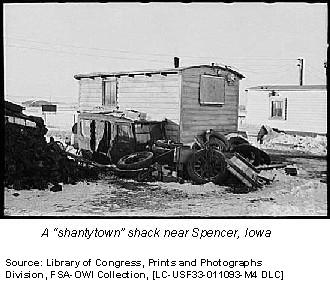 Many people lost their homes, farms, or small businesses. Many banks failed, and people lost money they had deposited. A number of big businesses collapsed, and workers lost their jobs. By 1932 about 15 million people were unemployed. Many workers lost everything and wandered about the country looking for work. Homeless people built crude wooden shelters and lived in shantytowns in large cities. They called the shantytowns "Hoovervilles," after President Herbert C. Hoover. A Republican, Hoover had come to office early in 1929, before the stock market crash.
Many people lost their homes, farms, or small businesses. Many banks failed, and people lost money they had deposited. A number of big businesses collapsed, and workers lost their jobs. By 1932 about 15 million people were unemployed. Many workers lost everything and wandered about the country looking for work. Homeless people built crude wooden shelters and lived in shantytowns in large cities. They called the shantytowns "Hoovervilles," after President Herbert C. Hoover. A Republican, Hoover had come to office early in 1929, before the stock market crash.
When the depression hit, Hoover tried to assure everyone that prosperity "was just around the corner." He used federal money to aid farmers and to spur big business. He believed that if business could get on its feet, there would be enough jobs again, and the good times would return. But he held back from giving direct federal aid to the homeless and jobless. This aid, he thought, should come from local governments. Local governments, however, did not have the money or resources to meet this need.
In 1932 Franklin D. Roosevelt ran for president on the Democratic ballot. He promised a "new deal" for forgotten farmers and jobless workers. Roosevelt won the election.
Roosevelt immediately began to put New Deal programs to work. He placed restrictions on big business that regulated working hours, wages, and prices. He gave direct federal aid to small business owners, farmers, and even artists and musicians. He created new jobs by providing federal money to build hospitals, schools, libraries, and other public projects.
The New Deal began to have some effect. More people had jobs and money to spend. Banks were sound again, and the stock market was stable. By 1940 the worst years of the Great Depression were over. But it had taken a long time, many people had suffered, and the gains in big business and industry were still moving at a slow rate.
Back to Top
World War II
The 1920s were not as enjoyable in the rest of the world as they had been in the United States. World War I had left parts of Europe in ruins. People were sick and hungry; industries were destroyed; nations were in debt from the costs of the war. The people of Germany suffered the most. Countries of Western Europe demanded that Germany pay them for the damages they had suffered. Paying these damages made Germany's hopes for rebuilding itself the bleakest in Europe. The German people were not only homeless and unemployed, they also felt bitter and defeated. Many German leaders tried to solve the country's problems. The leader of the Nazi party finally won out over all the others. His name was Adolf Hitler.
During his rise to power Hitler promised to restore German pride and strength by expanding Germany's borders in Europe. He promised new factories and jobs. He also made up lies in which he blamed various ethnic groups in Germany (particularly the Jews) for the country's problems. By the early 1930s Hitler's support was strong enough to make him dictator of Germany. Hitler kept his promises and rebuilt German factories. Before long, the factories were making guns and war machinery. The Nazis began mistreating the Jews; many German Jews fled to other countries, including the United States.
By 1938 Hitler's war preparations were ready. Germany demanded and got lands in Austria and Czechoslovakia. Thinking Hitler would be satisfied, no other countries objected. A year later, however, Germany invaded Poland. England had formed an earlier alliance with Poland, promising to help if Poland was attacked. England and France both declared war on Germany in 1939. World War II had begun.
At the beginning of the war England and France were the Allies. They faced the Axis, made up of Germany, Japan, and Italy. These three countries had signed a treaty aimed at world conquest. In Asia, the Axis nation Japan invaded China and prepared to take over Southeast Asia.
People of the United States watched what was happening in Europe and Asia. They sympathized with France, England, and China. But most Americans believed that the country must never again take part in foreign wars. This widespread belief was called isolationism. American isolationists got Congress to pass a neutrality act. This law banned the sale of war goods to any country engaged in war.
Germany went on to conquer most of Europe. In 1940 France surrendered. This left England alone in the fight against the Axis powers. England's position was desperate. German submarines roamed the Atlantic and sank hundreds of English ships. German planes bombed English cities nightly. With Winston Churchill as their leader, the English people fought on against great odds.
President Franklin Roosevelt feared that if England fell, Hitler's thirst for world power would extend to the Western Hemisphere. Roosevelt began sending much-needed supplies to England. He also got a draft law passed to enlarge the U.S. army.
The Soviet Union had stayed out of the conflict. The Soviet leader, Stalin, had signed a pledge with Hitler. Each agreed not to attack the other. In the summer of 1941 Hitler broke his pact with the Soviet Union and invaded Soviet territory. The United States began sending supplies to the Soviets, too.
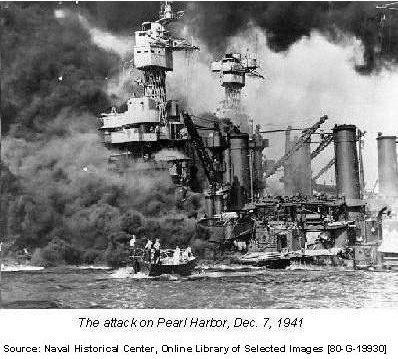 On December 7, 1941, Japanese planes bombed the U.S. naval base at Pearl Harbor in Hawaii. The United States declared war on Japan; Germany an Italy then declared war on the United States. The country was at war with the Axis powers on two fronts—in Europe and in Asia.
On December 7, 1941, Japanese planes bombed the U.S. naval base at Pearl Harbor in Hawaii. The United States declared war on Japan; Germany an Italy then declared war on the United States. The country was at war with the Axis powers on two fronts—in Europe and in Asia.
The United States joined the Allies in concentrating on Europe first. The Germans had overrun most of Europe and North Africa. With heavy losses on both sides, the Soviets stopped the German advance just outside Moscow. English and U.S. armies took North Africa and Italy. Finally, the long-awaited major Allied invasion of Europe came on June 6, 1944. Canadian, U.S., and English forces landed on the coast of France in the D-Day Invasion at Normandy. They fought their way to Germany over the next year. Germany surrendered in May of 1945.
After Germany's surrender, the U.S. and its allies turned their full attention to the war against Japan. The war in the Pacific had gone badly for the United States at first. Japan captured the U.S. territory of the Philippines and many small Pacific islands. The Japanese also took English, Dutch, and French colonies in Southeast Asia. In 1942 U.S. forces won a major sea battle near the island of Midway. In 1944 they invaded Japanese bases in the Philippines. Yet the Japanese showed little interest in surrender, even after Germany's defeat.
In August, 1945, the United States dropped atomic bombs on the Japanese cities of Hiroshima and Nagasaki. The horrible deaths and fires that resulted from these bombings convinced the Japanese that the war now threatened the islands of their homeland. Japan surrendered nine days after the first bombing.
World War II was over. About 45 million people had been killed. More than one million U. S. soldiers—three times as many as in World War I—were dead or wounded. Other countries had lost many more millions—soldiers, old people, women, and children. The Nazi Holocaust had murdered 6 million Jews and millions of other ethnic people. Tens of thousands of Japanese had died almost instantly in the atomic bombings of Hiroshima and Nagasaki. Americans and people everywhere looked back on years of horror and tragedy; they looked ahead with mixed fears and hopes.
Back to Top
 For the first time, U.S. factories were mass-producing automobiles. Almost anyone could afford a car. A new Model T Ford cost only a few hundred dollars. Hollywood became the movie capital of the world and produced cheap entertainment for everyone. The new radios were just as inexpensive. A small one cost about $20 and lasted for years. Radios and phonograph records both helped to make the lively new jazz music popular. Prohibition took effect in 1920, making the sale of alcoholic beverages illegal. Gangsters quickly began to make their own liquor and beer and sold it in "speakeasies." Speakeasies were nightclubs that ignored prohibition laws. Crime rose rapidly during the 1920s.
For the first time, U.S. factories were mass-producing automobiles. Almost anyone could afford a car. A new Model T Ford cost only a few hundred dollars. Hollywood became the movie capital of the world and produced cheap entertainment for everyone. The new radios were just as inexpensive. A small one cost about $20 and lasted for years. Radios and phonograph records both helped to make the lively new jazz music popular. Prohibition took effect in 1920, making the sale of alcoholic beverages illegal. Gangsters quickly began to make their own liquor and beer and sold it in "speakeasies." Speakeasies were nightclubs that ignored prohibition laws. Crime rose rapidly during the 1920s. In February of 1898, the U.S. battleship Maine was mysteriously blown up on a visit to Cuba. More than 200 U.S. sailors were killed in the explosion. U.S. newspapers immediately demanded war against Spain, and most people agreed with the newspapers. President William McKinley reluctantly gave in.
In February of 1898, the U.S. battleship Maine was mysteriously blown up on a visit to Cuba. More than 200 U.S. sailors were killed in the explosion. U.S. newspapers immediately demanded war against Spain, and most people agreed with the newspapers. President William McKinley reluctantly gave in.
 As war threatened, Russia called up its troops. This worried Germany because it was caught between Russia on the east and France on the west. So the Germans invaded Belgium to get into France before the Russians attacked them. Belgium had an alliance with England, so England declared war on Germany when it invaded Belgium. World War I had begun.
As war threatened, Russia called up its troops. This worried Germany because it was caught between Russia on the east and France on the west. So the Germans invaded Belgium to get into France before the Russians attacked them. Belgium had an alliance with England, so England declared war on Germany when it invaded Belgium. World War I had begun.
 Many people lost their homes, farms, or small businesses. Many banks failed, and people lost money they had deposited. A number of big businesses collapsed, and workers lost their jobs. By 1932 about 15 million people were unemployed. Many workers lost everything and wandered about the country looking for work. Homeless people built crude wooden shelters and lived in shantytowns in large cities. They called the shantytowns "Hoovervilles," after President Herbert C. Hoover. A Republican, Hoover had come to office early in 1929, before the stock market crash.
Many people lost their homes, farms, or small businesses. Many banks failed, and people lost money they had deposited. A number of big businesses collapsed, and workers lost their jobs. By 1932 about 15 million people were unemployed. Many workers lost everything and wandered about the country looking for work. Homeless people built crude wooden shelters and lived in shantytowns in large cities. They called the shantytowns "Hoovervilles," after President Herbert C. Hoover. A Republican, Hoover had come to office early in 1929, before the stock market crash. On December 7, 1941, Japanese planes bombed the U.S. naval base at Pearl Harbor in Hawaii. The United States declared war on Japan; Germany an Italy then declared war on the United States. The country was at war with the Axis powers on two fronts—in Europe and in Asia.
On December 7, 1941, Japanese planes bombed the U.S. naval base at Pearl Harbor in Hawaii. The United States declared war on Japan; Germany an Italy then declared war on the United States. The country was at war with the Axis powers on two fronts—in Europe and in Asia.